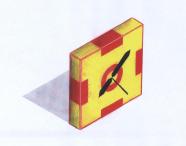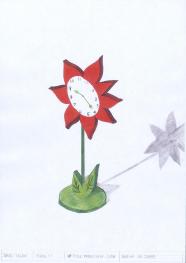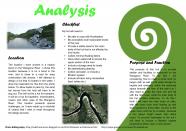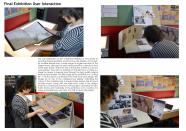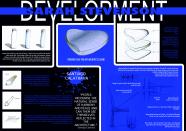Design and visual communication: Expect great things
Introduction
Design and visual communication (DVC) is very popular at Onslow College: three classes at level 6, two at level 7, and two at level 8. In the junior school, 40 percent of students choose to include DVC in their programmes. This popularity is due to a culture of high expectations and high achievement fostered by graphics duo Ron van Musscher and Emily Barnes.
Within this culture, students of DVC at Onslow College:
- are achieving results that are above the mean for their decile
- have had considerable success in scholarship
- have often gone on to design-related tertiary studies and careers.
Background
Onslow is a co-educational school of about 1250 students.
Ron and Emily had worked together as a teaching partnership for eight years. Both came to teaching with a design background. Ron is a graduate of Elam School of Fine Arts (Industrial Design and Photography) with 20 years of industrial design experience. Emily is a graduate of Victoria School of Architecture with four years’ interior design experience. Given their backgrounds, they have been in a strong position to advocate for the career potential of design. Ron says:
“We are keen to show the students in every way possible what designers do.”
Ron van Musscher
The message obviously gets through, with nearly half of all year 13 DVC students going on to tertiary study in design or architecture.
Planning
Ron and Emily like the way is unpacked in the Teaching and Learning Guide. They are also positive about the achievement standards that came out of the standards alignment process:
“The way they are structured makes it easier for us to plan programmes that embed authentic graphics practice and design processes. We now have assessment standards for assessing skills and others for process.”
Ron van Musscher
Strong foundations and transitions
The rewritten standards provided the catalyst for a ground-up review of their programme. Knowing what was required at level 8 of the curriculum, they began by modifying their year 13 programme and then worked backwards through the years, ensuring that at each level, the programme would provide a strong foundation for the next.
At Onslow, students in year 9 are able to choose DVC for half of the year as a foundation course and, in year 10, as a foundation course or an advanced course. Emily believes that this is a key factor in student success.
“We are able to build a strong foundation with this amount of time. Junior DVC is a prerequisite for senior DVC. Students who do not have this foundation really struggle.”
Ron van Musscher
Each year’s programme is built around a project and a product design project. The year 13 projects are modified versions of the year 12 projects, and so on down to year 9.
At year 13, the aim is to open up the programme, make it more student directed, and generally to allow it to be more abstract and esoteric.
“We are keen for them to develop their interpretative skills as this prepares them better for university. Sometimes a university task is a single word. So in year 13, briefs are negotiable – starting points rather than constraints.”
Ron van Musscher
While suggested briefs are provided, year 13 students are encouraged to explore contexts that are of particular interest to them. Emily and Ron will rewrite a brief with the student to enable this.
At the other levels, projects are chosen either to give students a vehicle for learning particular drawing skills or to develop their ability to follow a design process. Senior school projects need sufficient complexity to allow students to achieve merit and excellence as measured against NCEA standards.
Onslow graphics, calendars (Word 2007, 136 KB)
High expectations
Ron and Emily stress that aspiring design students need a strong work ethic. Although NZQA recommends 18 credits per full-year programme, theirs comprises 24, which they acknowledge is a big workload. They do review the situation each year, and with individual students, but they don’t apologise for the demands.
“It is part of our teaching to have high expectations. And, in any case, the students are learning the skills and processes as part of the curriculum so why not value their work through assessment and credits?”
Ron van Musscher
Both teachers are in regular email contact with parents, discussing the progress of their student.
Teaching strategies
Technology Online asked Emily and Ron what strategies they used to turn high expectations into high achievement.
A studio environment
One important strategy is to provide the right physical environment. This means, for example, that the walls (and even some windows) are covered with display boards that feature the students’ work.
“We like students to work in a space where they can see each others' work. In fact, we insist students display work at every opportunity.”
Ron van Musscher
Every effort has been made to create a space that feels like a designers’ studio. In their studio, students have access to the kinds of equipment that a designer would normally have access to. This includes, light boxes (built using recycled industrial lighting), digital camera, lamps, tripods, markers, pencils, different papers, and modelling resources.
The two graphics classrooms share a computer pod positioned between them. While this pod is available only with teacher supervision and the camera is secured, the students have free access to all other equipment and are respectful of this.
In keeping with the , the two teachers operate in a studio-based manner, working with individual or small groups of students, and with a minimum of “chalk and talk”.
Self-management
To reduce deadline stress, particularly as the end of the teaching year approaches, Ron and Emily strongly emphasise self-management strategies.
“We provide a calendar at the beginning of the year outlining the year’s programme. We also have a project calendar and weekly expectations in terms of work outcomes. These are recorded on the board.”
Ron van Musscher
Checklists enable students to confirm that they have completed all the requirements of a brief.
Such strategies allow students to self-monitor and the teacher to easily assess progress and see who is in need of extra support.
Project checklist (Word 2007, 122 KB)
“We believe that self-management is a ‘work in progress’; our job is to provide a scaffold from which students can work. When students ask about what to do next, we direct them to where they already have the information and then check that they have understood.”
Ron van Musscher
All students want to work right up to the final deadline, so the dates for end-of-year submissions are staggered – a day apart for each level. This reduces queuing at the computers as students retrieve digitally stored work.
Exemplars
Students need to know what excellent design work looks like. For this reason, exemplars of student work are readily available on computer and in a set of A3 folders. Sometimes Emily and Ron project selected exemplars onto a screen to illustrate a teaching point or a part of a process.
Both teachers have created digital and hard copy resources, which they share with each other and their classes (and, increasingly, with other schools). These often focus on particular skills such as , perspective drawing, and the design process.
See the image galleries to the right of this page.
Visual communication literacy
"We advocate that the literacy of visual communication should be learnt by hand before going digital. Students don’t have the understanding of the complexity of design if they start with a digital programme. Drawing with a pencil can be very quick.”
Ron van Musscher
Publisher and Photoshop are used as tools for layout and . Students create their backgrounds and a page layout in Photoshop and then scan all of their images and type their notes into this. High standards of presentation are expected.
Google SketchUp is used a lot because it is free. Once the students have been shown previous students’ work and taught the basic functions, they are able to experiment on their own. For those who need help, there always seems to be peer expertise at hand:
“Often you will find that within the class there is a student who knows a lot about a particular programme and is keen to help fellow students. Their peers often catch on quicker as their language is more vernacular – we find that they often understand each other’s approach to learning new programs better than we do!”
Ron van Musscher
Other programs such as Publisher, Word, and PowerPoint have become much more image friendly over time and can now even be used as design tools.
In spite of the availability of good, everyday computer options, some students will always go back to drawing with a pencil as their preferred visual communication tool.
Exhibition
Each year at the end of term 3, year 13 students present an exhibition of their work. This allows them to be assessed for AS91628 Develop a visual presentation that exhibits a design outcome to an audience. Having completed their year’s work by the end of term 3, they use term 4 to collate it for external submission. The exhibition also shows year 12 students what they can aspire to and allows parents to celebrate the achievements of their sons and daughters.
Reflective practice
Ron and Emily continually review their teaching in order to enhance the learning of their students.
For example, Emily found her year 9 and 10 students often struggled to remember all the steps involved in drawing isometric circles:
“I did the task myself and developed the 10 steps into task sheets. Students respond better to purpose-built task sheets than to something out of a textbook. They are also useful for self-paced learning.”
Emily Barnes
Ron found that some students were unsure about how to write up their design evaluations, so he developed a set of leading questions and prompts as a scaffold:
“I give these to students at the beginning of a project and ask them to keep them in mind as they design. This makes for a more straightforward evaluation at the end. For year 9s, the simplest prompt is: ‘Describe what it is that you are doing.'"
Ron van Musscher
Students are encouraged to see modelling as a documentation process rather than just a record at the end of the project.
“We encourage students to build the story of their design through modelling, drawing, and sketching, and to record it as an ongoing digital diary.”
Ron van Musscher
Emily and Ron have also introduced ideation as a precursor to , setting up a range of possible experiences. For example, a visit, a specific image or piece of work from a noted designer, or random model shapes for the students to generate responses to. The students reinterpret their responses as shapes and forms and from these come new ideas.
“Asking students to generate concepts without teaching them skills to come up with ideas can mean that the concepts are derivative rather than creative. The world needs new ideas and thinking, not more of the same!”
Outcomes
Onslow’s DVC results are generally and consistently above the mean for decile 10 schools. Students have also had considerable success in Scholarship. DVC is a very popular subject with students. Many DVC students go on to design-related tertiary studies and careers.
What next?
Ron and Emily will continue to review their project briefs and teaching approach with the aim of further improving student learning and achievement.
And they have noticed the current popularity of overseas trips for students. A design trip to Europe or New York could be in the wind!


